
Ladysmith is a town in the Uthukela District of KwaZulu-Natal, South Africa. It lies 230 kilometres (140 mi) north-west of Durban and 365 kilometres (227 mi) south-east of Johannesburg. Important industries in the area include food processing, textiles, and tyre production. Ladysmith is the seat for both the Alfred Duma Local Municipality and Uthukela District Municipality.

The Battle of Spion Kop was a military engagement between British forces and two Boer Republics, the South African Republic and the Orange Free State, during the campaign by the British to relieve the besieged city Ladysmith during the initial months of the Second Boer War. The battle was fought 23–24 January 1900 on the hilltop of Spioen Kop(a), about 38 km (24 mi) west-southwest of Ladysmith and resulted in a Boer victory.

The State Artillery Regiment is a reserve artillery regiment of the South African Army.

Sir Edward Robert Prevost Woodgate was an infantry officer in the British Army.

The Relief of Ladysmith consisted of multiple efforts to relieve the city of Ladysmith by General Sir Redvers Buller during the Second Boer War. Buller and the Natal Field Force attempted to relieve the city through multiple offensive actions. The city had been under siege since 2 November, 1899, and Britain had sent General Buller to relieve the city. After consolidating his Forces at Estcourt through most of November and early December, he began his relief of the city. The attempts to relieve the city started on 15 December at the Second Battle of Colenso, in which the British forces were repelled by the Boers on the Tugela River. The next two attempts were repulsed by the Boers, however at the Battle of Pieters Hill in February 1900, the Boers were eventually beaten from the city and forced to withdraw to Botha's Pass near Newcastle. Buller and his Forces entered the city on February 28, 1900, officially ending the Siege of Ladysmith.
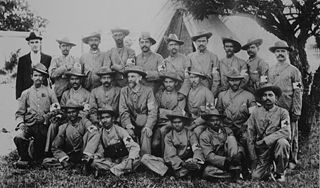
The Second Boer War was fought from 11 October 1899 until 31 May 1902, between the British Empire and the two independent Boer republics of the Orange Free State and the South African Republic. It was a lengthy war involving large numbers of troops which ended with the conversion of the Boer republics into British colonies, with a promise of limited self-government. These colonies later formed part of the Union of South Africa.

Okhahlamba Municipality is a local municipality within the uThukela District Municipality, in the KwaZulu-Natal province of South Africa.
Sir William Fry, was a British Army officer who served in the Second Boer War and the First World War, and later became Lieutenant Governor of the Isle of Man.

Spion Kop is a mountain in the province of KwaZulu-Natal, South Africa. It is located near the town of Ladysmith, 27 km to the WSW and about 2.5 km to the north of the Spioenkop Dam, a reservoir for the waters of the Tugela River.
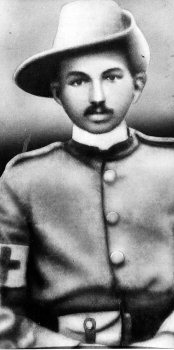
The Natal Indian Ambulance Corps was created by Mahatma Gandhi for use by the British as stretcher bearers during the Second Boer War, with expenses met by the local Indian community. Gandhi and the corps served at the Battle of Spion Kop. It consisted of 300 free Indians and 800 indentured labourers. It was committed to saving the lives of Africans and Indians. Gandhi was bestowed with the 'Kaiser-i-Hind' and other medals by the British for his work in Boer war. This was given up by Gandhi after the Jallianwala Bagh massacre in 1919.

Artillery Memorial, Cape Town was erected in memory of the gunners who fought for South Africa during World War I. The memorial, which forms part of the Delville Wood Memorial, is located in the Company's Garden, Cape Town, and was strategically established to commemorate South Africa's artillery soldiers who fell in battle. Of those who volunteered to fight during the war, 5800 were white South African, amongst whom 15% were Dutch and 85% English. An estimated 2536 of these men were killed in the Deville Wood battle in Europe. The Artillery Memorial, an authentic cannon facing east towards the National Gallery, proudly honors South Africa's heavy artillerymen. Inscribed on it are the names of the officers, N.C.O.'s and men of the South African artillery who fell in the Great War (1914–1918).
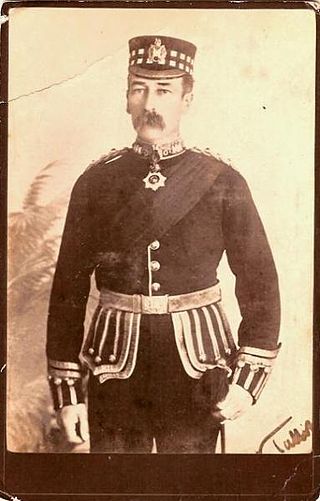
Major-General John Talbot Coke (1841–1912) of Trusley in South Derbyshire was a British Army officer who served in the 25th Foot between 1859 and 1901. He wrote a family history book called "Coke of Trusley, in the County of Derby, and Branches Therefrom; a Family History" which was published in 1880. He was a Brigade Commander during the Second Boer War having a prominent role in the battles of Spion Kop and the Tugela Heights during the relief of Ladysmith.
The Natal Field Force (NFF) was a multi-battalion field force originally formed by Major-General Sir George Pomeroy Colley in Natal for the First Boer War. It was later re-established for the Second Boer War (1899–1902) and commanded by Major-General Sir Redvers Buller VC GCB GCMG.
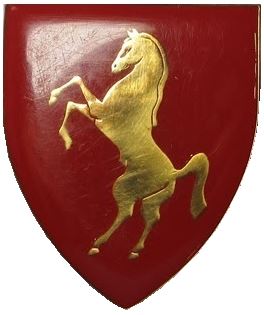
Carolina Commando was a light infantry regiment of the South African Army for the district of Carolina, South Africa. It formed part of the South African Army Infantry Formation as well as the South African Territorial Reserve.

Major General Alexander Whitelaw Thorneycroft, was a senior British Army officer during the Second Boer War.

Boksburg Commando was a light infantry regiment of the South African Army. It formed part of the South African Army Infantry Formation as well as the South African Territorial Reserve.

John Raymond Evelyn Stansfeld was a British army officer involved in the Relief of Ladysmith, the Battle of Spion Kop during the Boer War and the First Battle of Ypres. Stansfeld died at the Battle of Loos during World War I. He served with the Gordon Highlanders.

Sarel François Oosthuizen, 22 March 1862 – 14 August 1900) was a Boer War general. In 1920 he was posthumously awarded the Dekoratie Voor Trouwe Dienst, Anglo-Boeroorlog, 1899-1902.
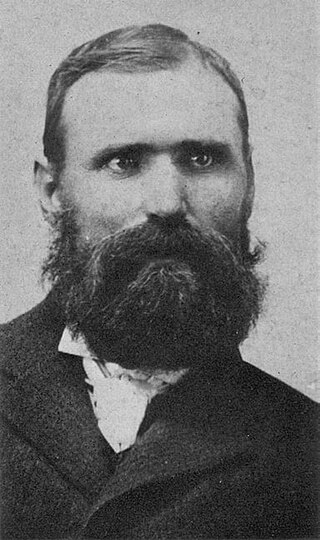
Hendrik Frederik Prinsloo was a Second Boer War commander of the Carolina Commando for the South African Republic who fought and prevailed at the Battle of Spion Kop. His son and namesake Hendrik Frederik Prinsloo (1890–1966) served as an officer in the South African Army in both World War I and World War II.






















